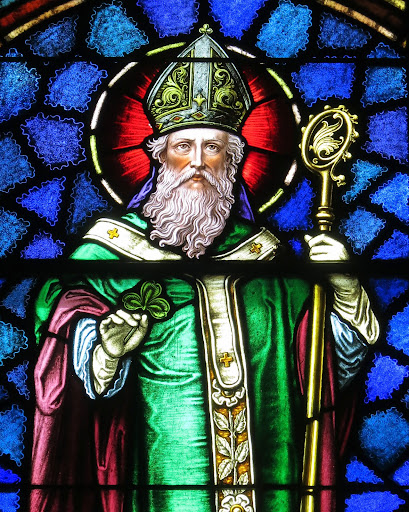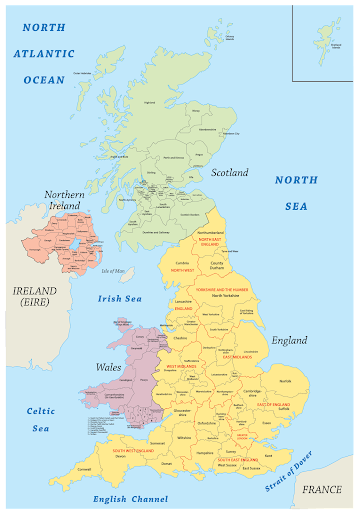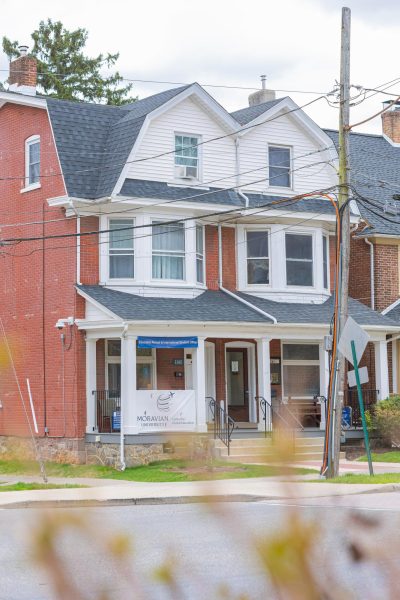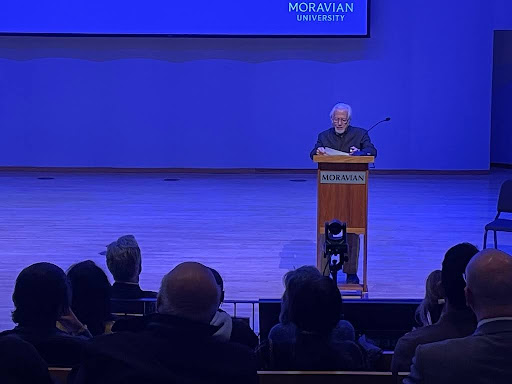Meanwhile, in Ireland: Saint Patrick

(A Stained Glass portrayal of Saint Patrick, depicted as a bishop, holding a Shamrock, from Wikimedia Commons, photo by Nheyob – Own work, CC BY-SA 4.0, https://commons.wikimedia.org/w/index.php?curid=39732088)
Saint Patrick’s Day, a day of global recognition and celebration of Irish people, has come and gone, but often the festivities continue long after. Did you know these things about Saint Patrick, Saint Patrick’s Day, and Ireland as a whole?
- IRISH LANGUAGE 101: Saint Patrick in Irish is Naomh Padraig (pronounced Neev Paw+Drig). To wish someone a happy Saint Patrick’s Day, you would say “Lá Fhéile Naomh Pádraig sona dhuit!” (pronounced law ay+luh Neev Paw+Drig soh+nuh gweech) if you were addressing one person, or “Lá Fhéile Naomh Pádraig sona dhaoibh!” (pronounced law ay+luh Neev Paw+Drig soh+nuh yeev) if addressing more than one. You could also say “Beannachtaí na Fhéile Naomh Pádraig dhuit (dhaoibh)!” (pronounced Bawn+awk+ tee naw ay+luh Neev Paw+Drig soh+nuh yeev) which means “Saint Patrick’s Day blessings be with you”.
- Saint Patrick was not Irish. He was actually a Briton, most likely from the borderlands of Wales. He first arrived in Ireland as a teenager after being captured by pirates and sold to a wealthy Irish lord, for whom he was to work. Patrick escaped back to Britain, only to return later as an adult to answer “God’s calling to be a missionary, a witness, to the Irish.”

- Saint Patrick was not called Patrick until after he became a Bishop. His original name was Maewyn Succat!
- Four Leaf Clovers, clovers with rounded leaves, have nothing to do with Ireland or Saint Patrick. The Shamrock, which is a related but separate plant entirely, however, bears only THREE leaves, which are heart-shaped. Before Patrick, the belief in the triple goddesses, goddesses with three aspects of one being, was incredibly significant. Patrick used the three-leaf shamrock, which is similar to the Triskelion symbol that often represented the triple goddess, to explain to the people what the Holy Trinity was.

Ireland’s National Colour is actually blue, not green. This comes from the Tudor Conquest of Ireland in the early 1500s. Henry VIII, upon naming himself officially the King of Ireland, created a crest for Ireland. This flag was blue, featuring a gold harp on it.

In 1642, Eoghan Ruadh Ó Néill (pronounced Owen Roe Oh Neel), Red Owen O’Neill, a notable rebel against England, took this flag and changed the blue background to green. Eventually, the Irish Tricolour, invented during the Young Irelander Rebellion of July 1848, was established as a symbol of rebellion against English rule.
Three colored bars were featured on the Tricolour. On the left is Green, representing the Catholic population. On the right is Orange, representing the protestants. Between them is white, which represents the hope for peace between the two parties.

- The “Banishing of the Snakes” actually has nothing to do with actual snakes, as in the animal. Ireland never had any actual snakes, to begin with. What is being referred to is actually the removal or otherwise mass murder of the Druids and anyone who refused to convert, an effort led by Patrick. Biblically, Satan is often represented by a serpent or snake, such as in the Garden of Eden. This is likely where the analogy of “Banishing the Snakes” originated from.
- Corned Beef and Cabbage was actually invented in New York City by a German Jewish person, though it is true that Irish immigration during and after The Great Hunger, an Górta Mór (pronounced Awn Gore+tuh More) in the mid-19th century, did have something of a hand in it – a sort of collaboration between the two immigrant parties. Either way, it is an American invention, and for the most part, only tourism-heavy areas of Ireland will sell it. Of course, there are some exceptions, but it is usually only sold because of tourism to Ireland by Americans. The real Irish way would be to have slithers of Irish bacon with a side of cabbage and perhaps some spuds.

Go raibh maith ’got, agus sláinte mhaith (pronounced Go Reye My Goht, Aw+Gus Slawn+chuh Why.) Thank you, and may good fortune and health go with you.






